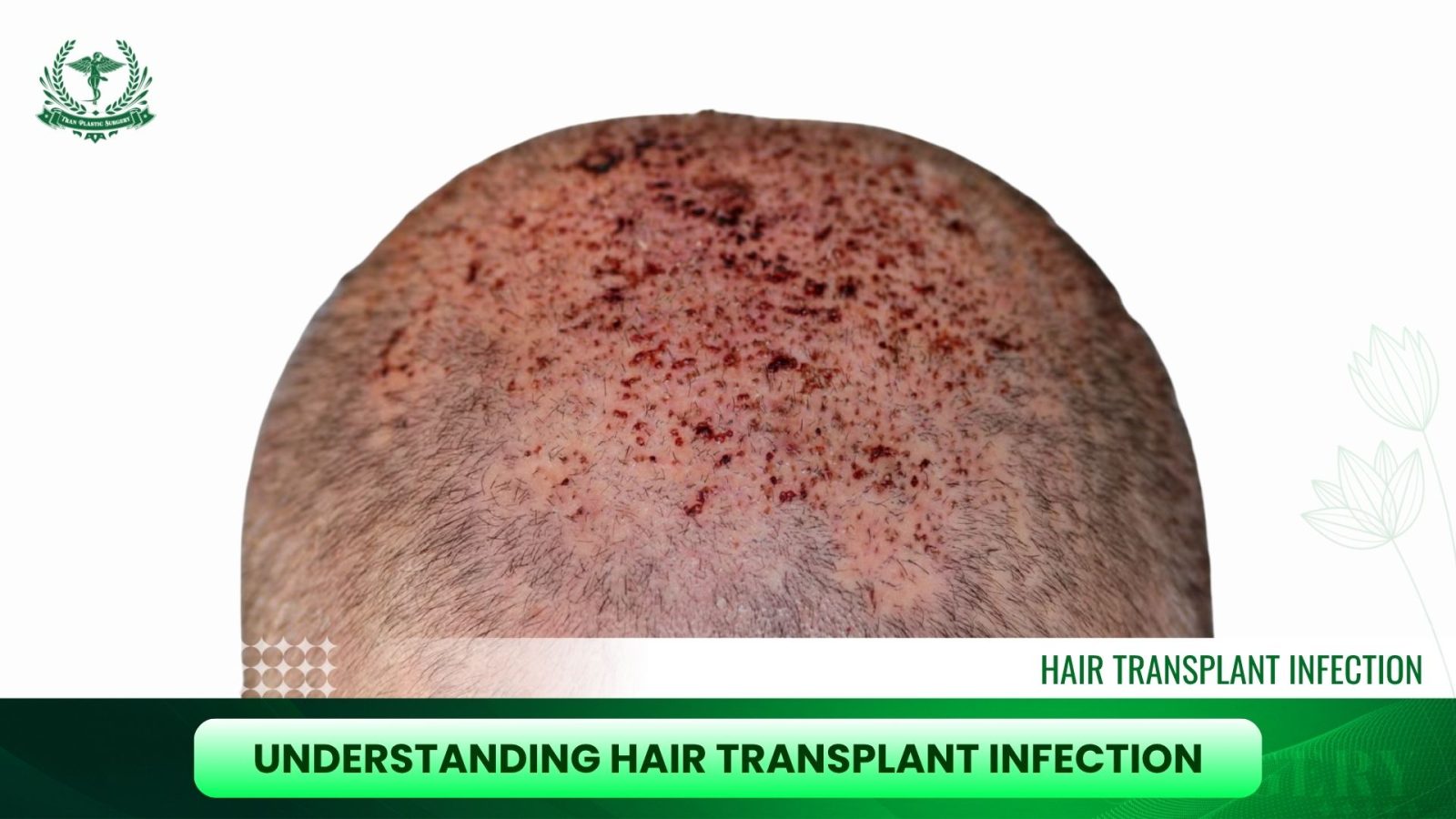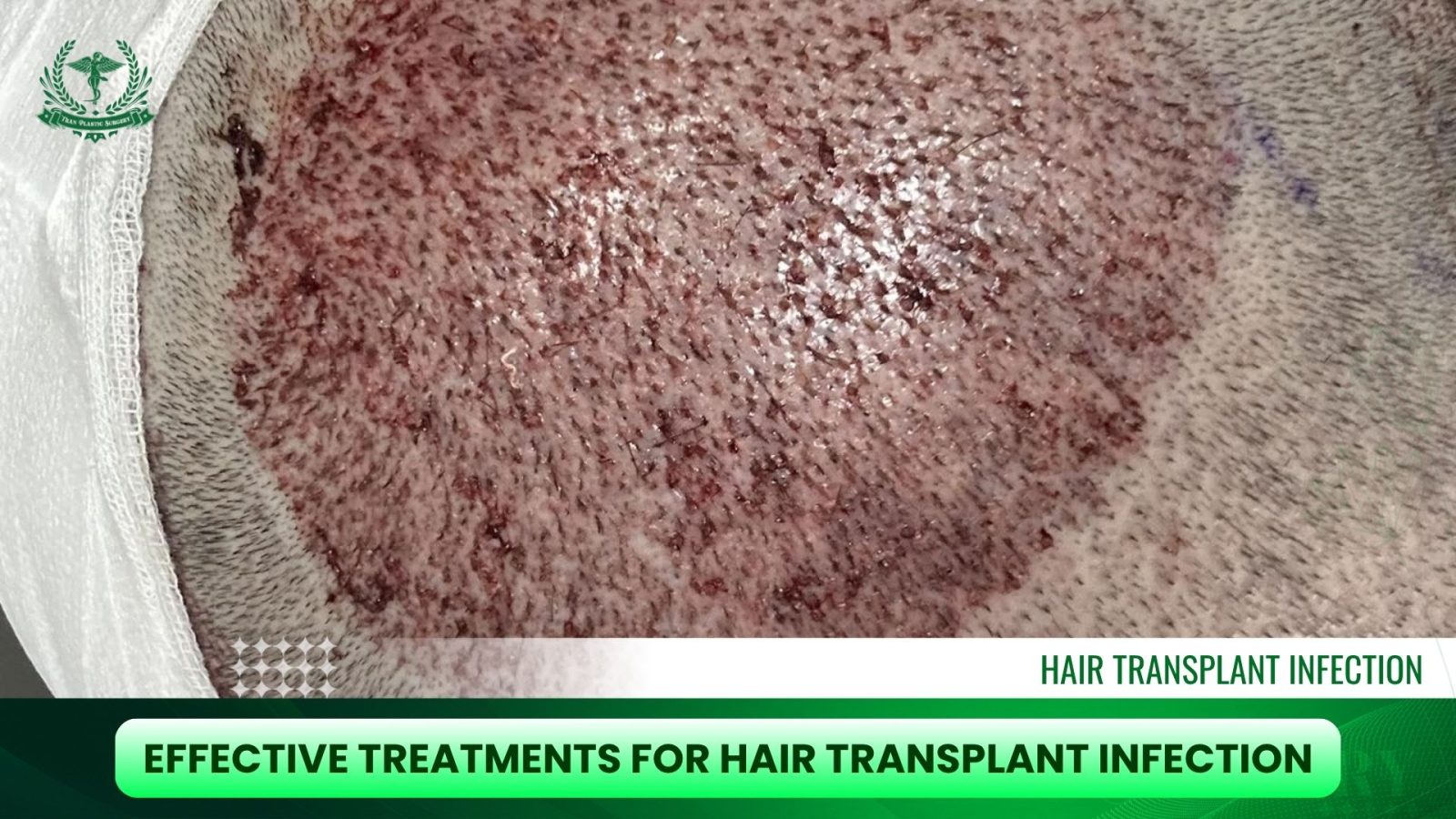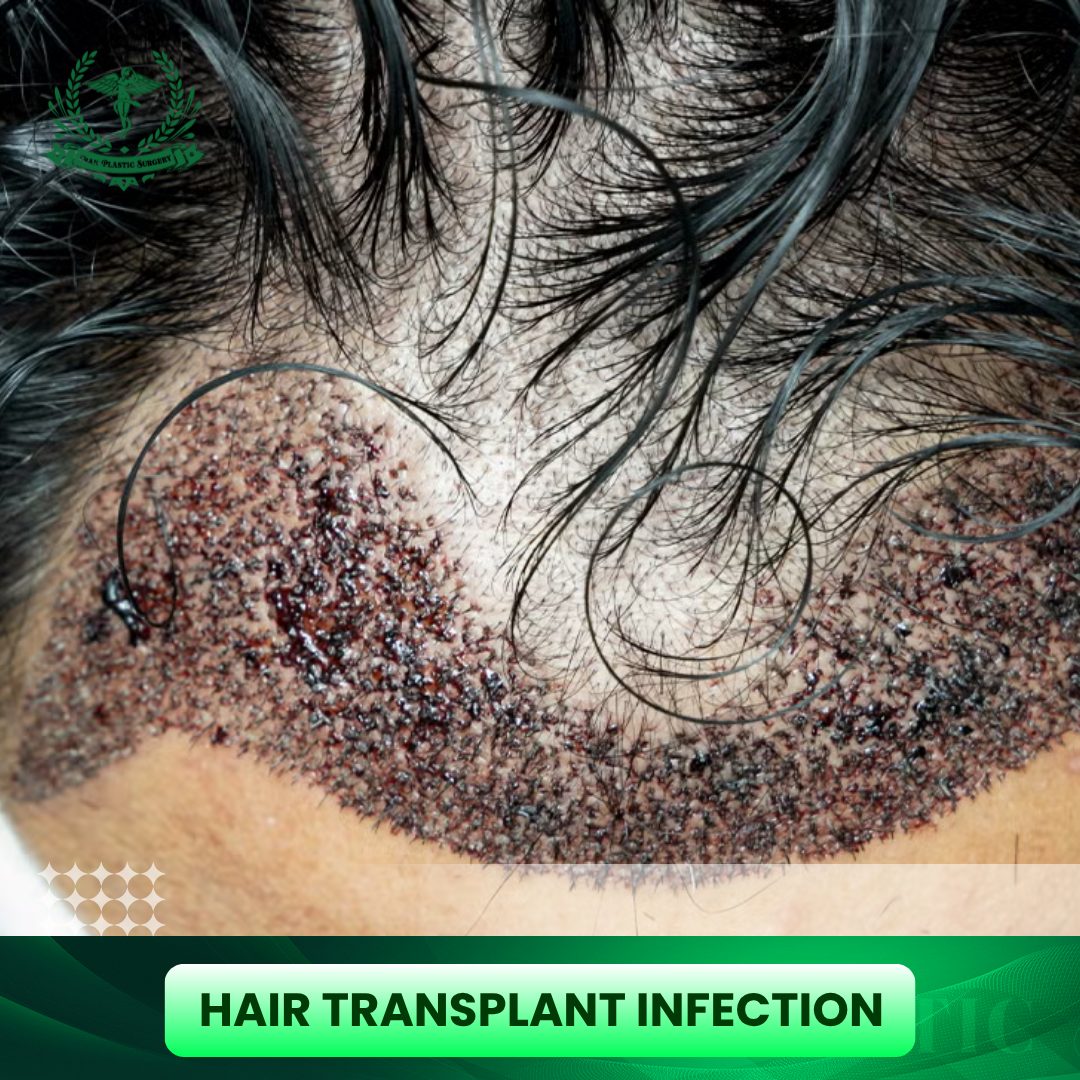Table of Contents
ToggleUnderstanding Hair Transplant Infection: What is it?
A hair transplant infection occurs when bacteria, fungi, or other microorganisms enter the scalp’s tiny surgical wounds created during the procedure. Even though modern hair restoration techniques such as FUE (Follicular Unit Extraction) and FUT (Follicular Unit Transplantation) have low infection rates, the risk cannot be entirely eliminated.
Symptoms of an Infected Hair Transplant
After a hair transplant, some redness, swelling, and mild tenderness are expected. These are normal signs of healing. The challenge for many patients is knowing when these normal symptoms turn into signs of an infection hair transplant. Here are the most common signs of an infected hair transplant you should never ignore:1. Redness and Warmth That Keep Getting Worse
Mild redness is normal for a few days, but if the area becomes increasingly red, warm, and painful after the first week, it could indicate an infection. This often happens in both the recipient area and the donor zone.2. Swelling and Tenderness
While slight swelling around the forehead or donor area is expected, swelling that continues to spread or becomes painful can be a sign of an infected hair transplant follicle.3. Pus or Yellowish Discharge
The presence of pus-filled bumps, drainage, or a foul odor indicates bacterial activity. This is one of the clearest signs of a hair follicle transplant infection and needs prompt medical attention.4. Excessive Itching and Burning Sensation
Mild itching is a normal part of healing, but if it becomes severe or is accompanied by burning, this may suggest an infection. Some patients even describe small pustules or bumps forming around each graft, known as folliculitis.5. Fever or Chills
Fever is a warning that the infection may have spread beyond the scalp. This is rare but serious and requires immediate treatment.6. Delayed Healing or Graft Loss
If scabs do not fall off within two weeks or grafts appear to be dislodging, it might be a sign of hair transplant infection interfering with the healing process. Timing matters: Most infections develop within the first week, which is why some people refer to it as a 1 week hair transplant infection. If you notice worsening pain, swelling, or drainage during this time, contact your surgeon immediately. >>> Read more: What is Alopecia? Causes & Natural Treatments for Hair LossCauses and Risk Factors of Hair Transplant Infection
Understanding what causes an infection can help you prevent it. At Tran Plastic Surgery, we see several common reasons behind an infected hair transplant:1. Poor Sterilization or Surgical Hygiene
When equipment or surgical environments are not properly sterilized, bacteria can enter the open wounds on your scalp. This is one of the main causes of botched hair transplant infection cases performed at unlicensed or low-cost clinics.2. Improper Aftercare
Not following post-operative care instructions is a leading reason for infection. Touching your scalp with unclean hands, scratching at scabs, or failing to wash gently as instructed can introduce bacteria.3. Excessive Crusting and Itching
If scabs are not softened and cleaned properly, they can trap bacteria underneath, leading to inflammation and infection.4. Health Conditions and Lifestyle Factors
Patients with diabetes, smokers, or those with weakened immune systems are more prone to infection because their bodies heal more slowly.5. Overharvesting in the Donor Area
An infected donor area may occur when too many grafts are extracted from the back of the scalp, leaving it overexposed and difficult to heal. This can lead to redness, swelling, and pus formation.6. Unqualified or Inexperienced Surgeons
A botched hair transplant infected follicles scenario often results from poorly performed procedures in non-sterile environments or by untrained staff. These cases can lead to permanent scarring, graft failure, and disfigurement.
Effective Treatments for Hair Transplant Infection
If you suspect an infection after your procedure, do not wait. Early treatment can prevent permanent damage and restore the health of your scalp. At Tran Plastic Surgery, we follow a medically proven infection management protocol to ensure every patient receives safe and effective care.1. Clinical Evaluation
Your surgeon will inspect both the donor and recipient areas to determine the severity of the infection. This includes checking for pus, redness, tenderness, and warmth.2. Cultures and Lab Tests
If necessary, a sample of the discharge may be collected to identify the type of bacteria causing the infection. This helps in choosing the most effective antibiotic.3. Medication
Mild infections are usually treated with topical antibiotics and antiseptic shampoos. For more serious infections, oral antibiotics may be prescribed to stop bacterial growth quickly.4. Drainage and Cleaning
In cases with abscesses or pus buildup, the area may need to be carefully drained by a professional to prevent the infection from spreading.5. Pain Management and Anti-Inflammatories
To reduce discomfort, your surgeon may recommend anti-inflammatory medications and cooling measures to soothe the scalp.6. Ongoing Monitoring
Follow-up visits are essential to confirm that the infection is clearing and no grafts are lost. Patients should never try to “pop” infected follicles or scabs themselves, as seen in some hair transplant infection popping videos online, which can worsen the condition.
Prevention: How to Avoid Hair Transplant Infection
The best way to handle an infection is to prevent it from happening in the first place. At Tran Plastic Surgery, prevention begins before the procedure and continues until full recovery.1. Before Surgery
- Choose a board-certified plastic surgeon who specializes in hair restoration.
- Disclose your full medical history, including any chronic illnesses or medications.
- Avoid alcohol and smoking for at least one week before surgery to improve blood flow and healing.
- Wash your scalp thoroughly the night before surgery as instructed.
2. After Surgery
- Keep the scalp clean and gently follow your surgeon’s washing routine.
- Avoid touching, scratching, or rubbing the transplanted area.
- Do not wear tight hats or helmets during the healing phase.
- Sleep with your head elevated to minimize swelling.
- Avoid swimming, gyms, or any environment that may expose your scalp to bacteria.
- Report any sign of redness, pain, or discharge immediately to your surgeon.
3. Healthy Lifestyle Choices
Good nutrition, adequate hydration, and avoiding smoking all promote faster healing. Patients who follow aftercare instructions closely have an extremely low risk of developing infection hair transplant complications.Botched Hair Transplants and Infections
Sadly, some patients experience infections due to poorly executed procedures performed abroad or by unlicensed technicians. A botched hair transplant infection not only affects the scalp’s health but can also result in emotional distress and financial loss. If you have had a botched hair transplant infected follicles case, you may need both infection management and corrective surgery. At Tran Plastic Surgery, we specialize in evaluating and repairing these cases to restore your scalp health and improve your results.Reduce The Possibility of Hair Transplant Infection, Should You Choose Tran Plastic Surgery?
At Tran Plastic Surgery, our mission is to combine artistry with medical safety. Every procedure is performed under strict sterile conditions to minimize the risk of infection. We use advanced FUE and FUT techniques and guide our patients through every step of recovery to ensure long-lasting, natural results. Our commitment to safety and transparency makes us one of the most trusted names in cosmetic and reconstructive procedures. We believe that informed patients make the best decisions for their health, and we are here to provide expert support at every stage of your hair restoration journey.
Conclusion
A hair transplant infection is rare but potentially serious. Recognizing the symptoms early, understanding what causes it, and getting timely professional care can prevent complications and protect your new hair grafts. If you suspect any sign of infection, do not wait. Contact your surgeon or visit Tran Plastic Surgery for an evaluation. Your health and results are our top priorities. With the right guidance, you can achieve the natural, confident look you deserve without unnecessary risk.(FAQs) About Hair Transplant Infection
1. How do I know if my hair transplant is infected?
If your scalp becomes red, swollen, painful, or starts oozing pus a few days after surgery, these are clear warning signs of infection. Other symptoms may include a warm sensation on the scalp, itching that worsens over time, or small bumps filled with pus around the transplanted follicles. If you experience any of these, contact your surgeon immediately.
2. When does a hair transplant infection usually appear?
Most infections appear within the first week after surgery, which is why many patients refer to this as a “1 week hair transplant infection.” Early redness is normal, but if it intensifies or spreads, it’s best to get it checked by a medical professional.
3. What causes a hair transplant to get infected?
The most common causes are poor hygiene during surgery, improper post-operative care, or exposure to bacteria through dirty hands, bedding, or unclean environments. Certain health conditions like diabetes and smoking can also slow healing and increase the risk of infection.
4. Can an infected hair transplant ruin my results?
Yes, if left untreated, an infection can damage hair grafts permanently. It may lead to scarring, patchy regrowth, or the loss of transplanted follicles. However, when treated early with antibiotics and proper medical care, most infections heal completely without affecting final results.
5. What should I do if I suspect my hair transplant is infected?
Do not try to treat it yourself or pop any bumps. Avoid applying random creams or home remedies. Contact your surgeon right away. A professional can prescribe the correct antibiotics and guide you on how to clean and care for your scalp safely.
6. What does a healthy healing hair transplant look like?
A healthy healing scalp will show mild redness and small scabs during the first week. These should gradually disappear without significant pain, swelling, or discharge. You may also notice slight shedding of transplanted hairs within the first month; this is normal and not a sign of infection.
7. How is a hair transplant infection treated?
Treatment usually includes topical antiseptics, antibiotic ointments, or oral antibiotics prescribed by your surgeon. In more severe cases, a minor drainage procedure may be required to remove trapped pus. With proper care, most infections resolve within one to two weeks.
8. How can I prevent infection after my hair transplant?
Follow your post-operative instructions carefully. Keep your scalp clean, avoid touching or scratching the grafts, and use only the recommended shampoo and medication. Also, avoid gyms, swimming pools, and excessive sweating until your surgeon clears you.
9. Are infections more common in the donor area or transplanted area?
Infections can occur in both areas, but the recipient area (where new follicles are implanted) is slightly more vulnerable because it has many tiny open channels. However, with good hygiene and professional aftercare, the risk remains extremely low.
10. What happens if I had a botched hair transplant and now have an infection?
A botched hair transplant performed in unsanitary conditions can easily lead to infection. If this happens, you should seek medical help immediately. At Tran Plastic Surgery, we specialize in treating botched hair transplant infections and performing corrective procedures to restore both scalp health and appearance.





